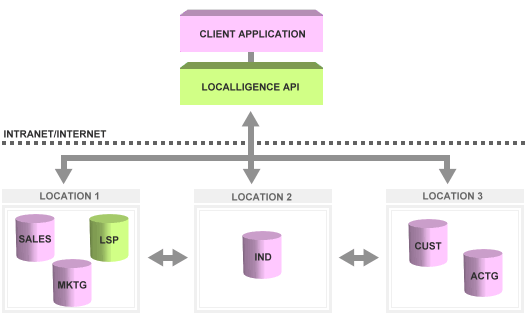|
|
|
The primary function of the Localligence Spatial Platform
(LSP) is to spatially enable an enterprise's data. As such
the LSP server
needs access to the various data sets that reside within an
enterprise. These data sets could be centrally managed in a
single location or distributed over multiple locations -
they could even be hosted at the Localligence data center.
Either way, this data needs to be accessible to the LSP in
order to leverage the benefits of location intelligence.
Illustration:
Client application accessing data from multiple locations,
with each location connected to a central Localligence
Spatial platform server (in green)

|
|
|
|
|
Customer
data is information that an organization gets about people
who visit, pay, buy or otherwise communicate with an
enterprise. Spatially enabling this data allows managers to
now "see" where their customer's are and either track
performance or plan how to better target their customer's
with additional products and/or services. Combined with
other marketing data, such as demographics and lifestyles,
manager's are able to literally "walk' the streets
of their customer's and gain a greater understanding of how
best to target and serve them.
|
 |
| |
|
|
|
|
|
Sales data
refers to addresses that are obtained for lead generation
exercises. This data can be purchased from third party
vendors, come from field marketers, in-store promotions or
other similar activities. As this data generally "costs" a
company, it is important that it is cleansed to ensure
maximum value from the investment. Data with a valid address allows company's to better target and deliver
pinpoint messaging about products and services.
|
 |
| |
|
|
|
|
|
Marketing
data is data that helps managers understand the environment
of their customer, for example, where they live. This data can be
provided free of charge, such as Census data, or purchased
from companies that specialize in segmenting people
(addresses) into certain profiles or lifestyles. For
example, in zip code 12345, 85% of the people are aged between 35 ~ 55, have two cars and a gross household
income between $85,000 ~ 110,000. The Localligence Spatial
Platform can take this data and, combined with an
enterprise's other data sets, provide a more intuitive
visualization of a company's existing and prospective
customers leading to better and more efficient methods for
planning how to sell, service and market products and
services.
|
 |
| |
|
|
|
|
|
The
Accounting department in any large organization is the one
that absolutely must have correct address information -
particularly for billing
and tracking purposes. Being able to accurately cleanse
these addresses and then position them on a map gives this
group unparalleled insight into where money is coming
and going. Using location intelligence can also help finance
departments better track instances of fraud and to raise
early warnings when questionable activity is clustered
around a specific address or location.
|
 |
| |
|
|
|
|
|
Industry
data is critical data that is generally purchased by an
enterprise to better understand sales of products and
services within their industry. For example, in the automotive
industry, Polk Automotive tracks the sales of vehicles across all brands and models.
Subscribing to Polk allows a company to better plan their
market and product strategies by reviewing what is working
or not working in the industry. Another example is Nielsen
EDI which tracks movie box office performance which is
invaluable information for companies involved in the
entertainment industry. By spatially enabling this industry
data companies
can now gain an even greater understanding of their own
product performance as well as that of their competitor's - helping
them better plan and respond to market dynamics and trends.
|
 |
|